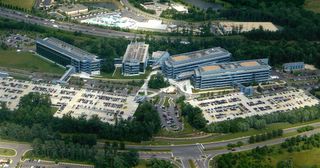Before I descended below the cloud deck and into the hubbub of this week's meeting in Seattle, I was able to catch a nice glimpse of Mt. Rainier:

Rainier 
The meeting iwas to look at what the deposits left by a tsunami can tell us about the event itself.
A friend to whom I mentioned this said Tsunami deposits? You mean, like, 'bodies and hotel furniture?' Umm, well, no - the deposits are mostly rocks, sand and mud. The basic question is what can the deposits tell us about the frequency of these events, and about the tsunami's speed, direction, evolution, and maybe even what caused it. As my friend well knew, these deposits are laid down in many areas that did not have resorts.
Here's a tsunami deposit, from a beach in Indonesia hit by both the December 2004 and March 2005 events. The photo was taken by one of the International Tsunami Survey teams, and given to me by Lori Dengler:


The hope is tha by looking at grain sizes, distributions, mineralogy, etc. that we might even be able to date and locate sources of tsunamis in order to get a better handle on local frequencies for these types of events.
The group meeting here is a sampling of the world's expert sedimentologists, geologists, geophysicists, hydrodynamicists, numerical modelers, database experts, etc. etc.
As part of the social events, many of us went to a Seattle Mariners baseball game on the evening of June 14 at Safeco Field (and this really does have to do with the topic...):

Safeco Field 
For our Japanese participants, the highlight of the game was when we saw Seattle's Ichiro hit his 1000th base hit, and of course to see him in right field:


It was also nice to be electronically welcomed to the stadium - although any fans paying attention to the scoreboard were probably also confused as to what, exactly, tsunami deposits were:

Scoreboard acknowledgment 
Well, during the latter part of the game, all of the sudden our group's cell phones went off like crazy. A large-ish earthquake had just occurred off the coast of Oregon, triggering a tsunami warning along the Western coasts of the U.S. and Canada. And, of course, the world's top tsunami specialists were all sitting at Safeco Field in Seattle, drinking beer.
We got the details from the callers (including some family members in Oregon who were being directly affected), had a quick discussion, decided the tsunami risk to the West coasts was minimal, and returned to drinking beer, talking to friends, and oh yes, occasionally watching baseball like the rest of the crowd. Why minimal? Because this was an earthquake in the middle of the Gorda plate, and was therefore very likely strike-slip rather than a thrust event - which meant that the amount of motion on the seafloor that displaced water was probably very small. This meant that the resulting tsunami would be very small (and in fact 20 minutes later, when the tsunami arrived, the tide gauges at Cresecnt City and Eureka measured less than one inch). Here's the location of the earthquake:

However, the lesson here is not one of complacency - there is a lot of evidence showing that the Pacific Northwest has been hit many times by tsunamis at least as big as the 2004 Indian Ocean event. And, like Indonesia, Washington and Oregon States will bear the brunt of the waves, with little to no time for evacuation. Here are maps showing the tsunami-genic Sunda and Cascadia subduction zones off Sumatra and the U.S.-Canadian West:

We left that game a fair bit later (Seattle won over the Phillies), and contemplated the brooding stadium next door in a strange evening light. Conversation ensued about how a city could get itself into such a political tangle that it accepted the building of two stadiums where one would have sufficed. Since I am from Washington DC, I kept my mouth shut.

Seattle night stadium 
Sure enough, the next morning the meeting was crawling with news media looking for the experts. This is the NBC Evening News crew's cameraman, filming one of the speakers:

NBC News Crew 
The result: some good pieces in the print media, and about ten seconds on the national news. Not bad, especially considering that the local authorities in Oregon got creamed for a failed radio alert network, and not being able to control the curious public who went down to the beach to watch for a tsunami.
The result from the workshop? A lot can be learned locally about effects and history of tsunamis, but the records are so heterogeneous and dispersed (especially the paleorecords) that putting together a picture of the source mechanism is proabably beyond our reach. Even in the best possible conditions, there is little chance of reconstructing the event itself. Even knowing the date and location of the events in December and March in the Indian Ocean, we would probably not be able to distinguish two separate events in the deposits a few years later, so the distinction in the photos at the top of this post would disappear. In addition, we know the topography enough to model wave run-up on land, and we know the deep-sea bathymetry well enough to model tsunami propagation, but we do not know the near shore bathymetry well at all - and that is critical for matching the models of deep-sea wave propagation with the on-shore run-up.
And Seattle? Seattle was left peacefully as before, waiting patiently to be swept away by a tsunami or buried in volcanic ash. An idyllic view from office windows at the University of Washington.

Husky Office view 













